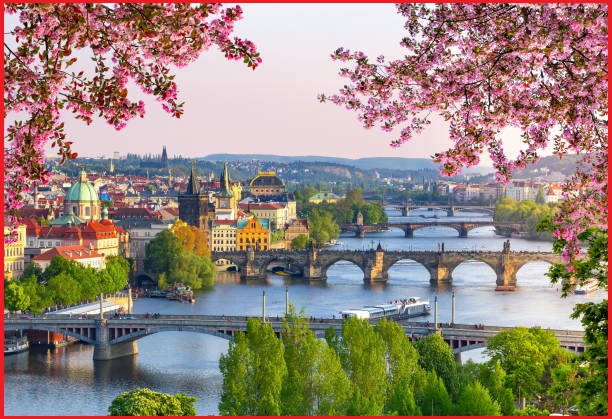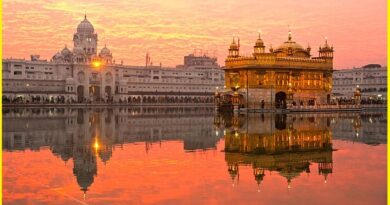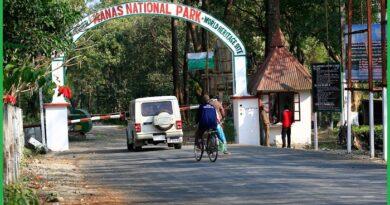Ultimate Guide to Czech Republic’s Top Attractions
Czech Republic
The Czech Republic is a central European country known for its rich history, stunning architecture, and picturesque landscapes. Czech Republic is bordered by Germany, Austria, Slovakia, and Poland. The country consists a mix of rolling plains, hills, and mountain ranges, including the Bohemian Forest, the Ore Mountains, and the Carpathian Mountains. The Vltava River is the longest in the country. Major cities include Brno, Ostrava, Plzeň (Pilsen), Liberec, and Olomouc with the capital city Prague.
Places to visit in the Czech Republic
The Czech Republic is known for its rich history, stunning architecture, and beautiful landscapes. Here are some must-visit places in the Czech Republic other than Prague-
Český Krumlov
Český Krumlov is a picturesque town in the South Bohemian Region of the Czech Republic, renowned for its well-preserved medieval architecture and charming ambiance. The town was established in the 13th century, around a castle built by the Vítkovci family. It flourished during the Renaissance period under the rule of the Rožmberk (Rosenberg) family, who were significant patrons of the arts and architecture. Main attraction include –
Český Krumlov Castle: A beautiful castle with a unique Baroque theater and panoramic views of the town. Includes a mix of Gothic, Renaissance, and Baroque elements. The castle tower offers panoramic views of the town. The Baroque Castle Theatre, which is one of the best-preserved Baroque theaters in Europe, and the beautifully landscaped castle gardens.
Old Town: A charming area with cobblestone streets, Renaissance and Baroque buildings, and the Vltava River meandering through. The town is famous for its narrow, winding streets, Baroque facades, and charming squares. Key locations include the historic Latrán district and the central town square, Náměstí Svornosti.
Karlovy Vary
Karlovy Vary, also known as Carlsbad, is a famous spa town in the West Bohemian region of the Czech Republic and is the Places to visit in the Czech Republic. Renoned for its hot springs, elegant architecture, and cultural events, it is a popular destination for both wellness and leisure tourism. Karlovy Vary was founded in 1370 by Emperor Charles IV, who was said to have discovered the hot springs. The town developed rapidly as a spa resort in the 18th and 19th centuries, attracting European aristocracy and notable figures. Main Attractions include-
Thermal Springs: Thermal springs are a key feature of Karlovy Vary, known for their therapeutic properties and historical significance. Karlovy Vary boasts 13 main hot springs, with numerous smaller springs and sources. The springs have temperatures ranging from 30°C to 72°C. The waters are rich in minerals, particularly bicarbonates, sulfates, chlorides, and a variety of trace elements, which are believed to have healing properties.
Mill Colonnade: The Mill Colonnade (Mlýnská kolonáda) in Karlovy Vary is one of the most prominent and iconic structures in the town. Designed by the famous Czech architect Josef Zítek, who also designed the National Theatre in Prague. Mill Colonnade was Built between 1871 and 1881.
Diana Observation Tower:
The Diana Observation Tower is a popular tourist attraction in Karlovy Vary, offering breathtaking panoramic views of the town and its surrounding landscape. The Tower was founded in 1370 by Emperor Charles IV, who was said to have discovered the hot springs. The tower is situated on Friendship Hill (Výšina přátelství), which is about 556 meters above sea level.
Kutná Hora
Kutná Hora is a historic town in the Central Bohemian Region of the Czech Republic, renowned for its rich history, stunning architecture, and UNESCO World Heritage sites. Kutná Hora dates back to the 13th century and became an important center for silver mining. The town’s silver mines contributed significantly to the wealth of the Bohemian Kingdom during the medieval period. Kutná Hora flourished during the 14th and 15th centuries, becoming a significant cultural and economic hub. Main Attractions Include-
Sedlec Ossuary (Bone Church)
Also known as the Bone Church, this small chapel is famous for its interior decorated with human bones. The ossuary contains the bones of an estimated 40,000 to 70,000 people, arranged in artistic patterns, including a chandelier made of bones.
Also Read- Vienna Delights: Must-Do Activities in Austria’s Capital
St. Barbara’s Church:
A magnificent Gothic cathedral dedicated to St. Barbara, the patron saint of miners. Known for its stunning flying buttresses, intricate frescoes, and beautiful stained glass windows. Considered one of the most important Gothic churches in Central Europe.
Italian Court:
Originally a royal palace and later the central mint for the kingdom. The Italian Court was where the Prague groschen, a major silver coin of the medieval period, was minted. Today, it houses a museum showcasing the history of coin minting and the economic history of Kutná Hora.
Brno
Brno is the second-largest city in the Czech Republic and serves as the capital of the South Moravian Region and is the Places to visit in the Czech Republic. Known for its vibrant cultural scene, historical landmarks, and modern attractions, Brno offers a diverse range of experiences for visitors. Brno’s history dates back to the early medieval period, with its first recorded mention in the 11th century. The city developed as a strategic military and economic center throughout the Middle Ages and Renaissance. Main Attractions include-
Špilberk Castle:
A medieval fortress founded in the 13th century was later converted into a baroque citadel and prison. Houses the Brno City Museum, showcasing the history and culture of the city. Offers panoramic views of Brno from its ramparts and tower.

Cathedral of St. Peter and Paul:
The Cathedral of St. Peter and Paul is a striking Gothic cathedral located on Petrov Hill. Known for its twin spires, beautiful interior, and the 11:00 bell-ringing tradition. One of the most important historical and architectural landmarks in Brno.
Villa Tugendhat:
A modernist villa designed by the architect Ludwig Mies van der Rohe in the 1920s. Celebrated for its innovative design, use of modern materials, and seamless integration with the surrounding landscape. It is a UNESCO World Heritage site and a masterpiece of modern architecture.
Plzeň (Pilsen)
Plzeň, known internationally as Pilsen, is a city in the western part of the Czech Republic, in the Plzeň Region. It is best known for its beer, particularly Pilsner, which originated here and influenced beer brewing worldwide. The city offers a rich history, a vibrant cultural scene, and several notable attractions. The city quickly grew into an important economic and cultural center, largely due to its strategic location and flourishing trade routes. Main Attractions include-
Pilsner Urquell Brewery:
The birthplace of Pilsner beer, offering brewery tours and tastings. Offers comprehensive tours that include a visit to the historic cellars, the modern brewery, and tastings of unfiltered Pilsner Urquell straight from the barrel. Features exhibits on the history of brewing, the brewing process, and the global impact of Pilsner beer.
St. Bartholomew’s Cathedral:
A Gothic cathedral located in the main square, Náměstí Republiky. Known for its impressive spire, which at 102.26 meters (335 feet) is the highest in the Czech Republic. Houses beautiful stained glass windows, medieval sculptures, and the Madonna of Plzeň, a revered Gothic statue.
Great Synagogue:
The second-largest synagogue in Europe and the third-largest in the world. Built in the Moorish-Romanesque style with striking twin towers and an ornate interior.
Olomouc
Olomouc is a historic city located in the eastern part of the Czech Republic, in the region of Moravia. It is known for its rich history, stunning architecture, and vibrant cultural scene. Olomouc dates back to the 10th century and has served as an important center of Moravian and Czech history. Throughout its history, Olomouc has been a significant religious, cultural, and educational hub in the region. Main Attractions include-
Holy Trinity Column:
A UNESCO World Heritage site and one of the most important Baroque monuments in Central Europe. The column stands 35 meters high and is adorned with statues depicting saints and scenes from the life of Christ. Built between 1716 and 1754, it symbolizes Olomouc’s faith during the devastating plague epidemics of the early 18th century.
Olomouc Astronomical Clock
The Olomouc Astronomical Clock (Olomoucký orloj) is a significant historical and cultural landmark located in the city of Olomouc, Czech Republic. The clock is situated on the facade of the Olomouc Town Hall (Radnice), which overlooks the Upper Square (Horní náměstí) in Olomouc. The clock combines elements of Gothic and Renaissance architectural styles and serves both decorative and functional purposes.
St. Wenceslas Cathedral
The main cathedral of Olomouc is situated within the castle complex. A stunning example of Gothic architecture with impressive vaulted ceilings and intricate stained glass windows. Houses the tomb of St. John Sarkander, a martyr of the Counter-Reformation.
Liberec
Liberec is a charming city located in the northern part of the Czech Republic, in the Liberec Region. It is known for its picturesque setting amidst the Jizera Mountains and the cultural richness it offers. Liberec was founded in the 13th century and developed as a center of trade and textile manufacturing. During the 19th century, it became an important industrial hub, particularly known for textile production. Main Attractions include-
Ještěd Tower
Located on the peak of Ještěd Mountain, this unique architectural landmark serves as both a hotel and a TV tower. Designed by architect Karel Hubáček, it is a prime example of modernist architecture with a hyperboloid structure. Offers stunning panoramic views of the surrounding countryside and the city of Liberec.
Liberec Zoo
The Liberec Zoo and Botanical Garden (Zoologická zahrada Liberec) is a popular attraction for families and nature enthusiasts. Home to a diverse range of animals and plants from around the world, including rare and endangered species. Liberec Zoo Offers educational programs, feeding sessions, and interactive exhibits.
IQlandia Science Center
IQlandia Science Center is a popular educational and interactive museum located in Liberec, Czech Republic. It focuses on science, technology, and natural history, offering a range of hands-on exhibits and activities for visitors of all ages. IQlandia is situated in the heart of Liberec, making it easily accessible for both locals and tourists. The science center aims to educate and inspire visitors through interactive exhibits that promote curiosity and exploration.
Moravian Karst
The Moravian Karst (Moravský kras in Czech) is a remarkable karst landscape located in the southeastern part of the Czech Republic, near the city of Brno. It is known for its extensive network of limestone caves, underground rivers, and unique geological formations. The Moravian Karst is characterized by its distinctive karst topography, which is formed by the dissolution of soluble rocks like limestone and dolomite. Includes sinkholes (dolines), caves, dry valleys (poljes), and underground drainage systems.
The Moravian Karst is a captivating destination for anyone interested in natural landscapes, geology, and outdoor activities. With its impressive cave systems, dramatic gorges, and diverse ecosystems, it offers a memorable experience that showcases the unique geological processes shaping the Czech Republic’s natural heritage.
Punkva Caves:
A stunning cave system with underground rivers and the Macocha Abyss. One of the most famous cave systems in the Moravian Karst. Features underground rivers, stalactites, stalagmites, and the Macocha Abyss, which is a deep sinkhole with a bottomless chasm. Visitors can take a scenic boat ride along the underground Punkva River to explore parts of the cave system.

Kateřinská Cave:
Kateřinská Cave (Kateřinská jeskyně) is one of the notable caves in the Moravian Karst region of the Czech Republic. Kateřinská Cave is located within the Moravian Karst Protected Landscape Area, near the village of Kateřinky, which is close to the town of Blansko. Like other caves in the Moravian Karst, Kateřinská Cave was formed through the dissolution of limestone by underground water over millions of years.
Třeboň
Třeboň is a picturesque town located in the South Bohemian Region of the Czech Republic, known for its historic architecture, beautiful landscape, and natural riches. Třeboň is the best Places to visit in the Czech Republic.
Třeboň Castle:
A significant landmark in the town center, Třeboň Castle dates back to the 12th century. The castle complex includes a Renaissance chateau and a Gothic tower, surrounded by a moat and gardens. Visitors can explore the castle grounds and visit the Třeboň Regional Museum, which exhibits local history, art, and culture. Třeboň boasts well-preserved Gothic, Renaissance, and Baroque architecture. The main square (Masaryk Square) is lined with colorful historical buildings, cafes, and shops. Founded in the 14th century, the monastery complex includes a church and cloisters.
Třeboň Ponds:
The Třeboň region is famous for its extensive network of man-made fishponds. Offers picturesque scenery, ideal for walking, cycling, and birdwatching. The ponds support a rich diversity of flora and fauna, including many species of waterfowl.
Telč
Telč is a picturesque town located in the Vysočina Region of the Czech Republic, renowned for its well-preserved Renaissance architecture and historical significance. It is a best Places to visit in the Czech Republic.
Telč Castle:
Telč Castle, originally a Gothic castle, was transformed into a Renaissance chateau in the 16th century. The chateau complex includes elegant arcades, a tower, and beautifully landscaped gardens. Along with the town square, the Telč Castle complex is a UNESCO World Heritage Site, recognized for its outstanding Renaissance architecture and urban design.
Historic Center:
The square is surrounded by colorful Renaissance and Baroque houses with arcades and gables adorned with sgraffito decorations. It features two picturesque fountains, including the Marian Column adorned with sculptures. Dominates the square with its imposing Renaissance facade and clock tower. A UNESCO World Heritage site with well-preserved Renaissance and Baroque buildings.
These locations offer a mix of history, culture, architecture, and natural beauty, making the Czech Republic a fascinating destination for travelers.
Prague
Prague, the capital city of the Czech Republic, is renowned for its stunning architecture, rich history, and vibrant cultural scene and is the Places to visit in the Czech Republic. Prague captivates visitors with its blend of Gothic, Baroque, and Renaissance architecture, vibrant cultural scene, and rich history. Whether exploring historic landmarks, indulging in local cuisine, or enjoying the city’s lively atmosphere, Prague offers an unforgettable experience that reflects the soul of Central Europe.
Prague Castle:
One of the largest ancient castles in the world, dating back to the 9th century. The Castle consists of a historic castle complex with stunning architecture, museums, and beautiful views of the city. Features includes the Gothic St. Vitus Cathedral, the Romanesque Basilica of St. George, and numerous palaces and gardens. Offers panoramic views of the city from its elevated position on the Hradčany hill.
Charles Bridge:
A historic bridge adorned with statues, offering picturesque views of the Vltava River. The iconic medieval bridge connecting the Old Town (Staré Město) with the Lesser Town (Malá Strana). Lined with statues of saints and offering stunning views of Prague Castle and the river.
Old Town Square:
Famous for the Astronomical Clock, vibrant markets, and the Gothic Church of Our Lady before Týn. Dominated by the Gothic-style Church of Our Lady before Týn and the Old Town Hall. Bustling square with street performers, outdoor cafes, and historic buildings.
St. Vitus Cathedral:
St. Vitus Cathedral (Katedrála svatého Víta) is one of Prague’s most iconic landmarks, situated within the Prague Castle complex. Construction of St. Vitus Cathedral began in the 14th century, though it took centuries to complete. Represents a mix of Gothic, Renaissance, and Baroque architectural influences due to its extended construction period. Serves as the main cathedral of the Archdiocese of Prague and is the largest and most important church in the Czech Republic.
How to reach the Czech Republic
Reaching the Czech Republic is relatively easy due to its central location in Europe and well-developed transportation infrastructure. Prague Airport (Václav Havel Airport Prague) is located about 17 km west of Prague city center. Direct flights from major cities across Europe, North America, Asia, and other parts of the world. Easily accessible by taxi, airport express buses, and regular public buses, as well as by the Airport Express (AE) shuttle to Prague’s main train station (Hlavní nádraží).
By Train
EuroCity (EC) and InterCity (IC) Trains: Connect major European cities like Vienna, Berlin, Budapest, Munich, and Warsaw to Prague and other Czech cities. Domestic Trains: An efficient train network connects Prague with other cities and towns within the Czech Republic.



